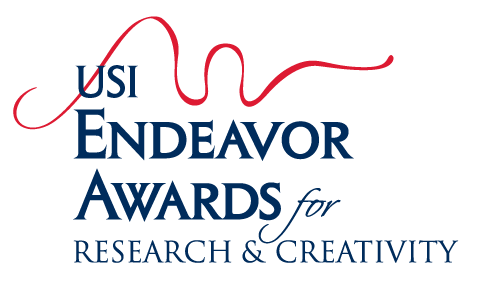 Welcome to the 19th Annual USI Endeavor Awards Symposium for Research and Creativity!
Welcome to the 19th Annual USI Endeavor Awards Symposium for Research and Creativity!
View a gallery of posters in full resolution
View the full symposium program
Storytelling with Preschoolers
Norah Baehl
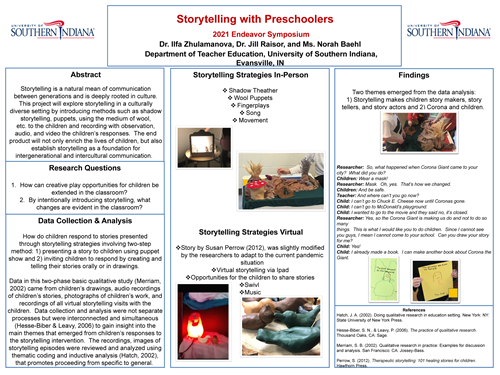
Faculty Mentors: Drs. Jill Raisor and Ilfa Zhulamanova
Storytelling is a natural mean of communication between generations and is deeply rooted in culture. This project will explore storytelling in a culturally diverse setting by introducing methods such as shadow storytelling, puppets, using the medium of wool, etc. to the children and recording with observation, audio, and video the children’s responses. The end product will not only enrich the lives of children, but also establish storytelling as a foundation for intergenerational and intercultural communication.
Drug-Gene Interactions of Epilepsy Medications
Josi Barscz and Sydney Ingler
Faculty Mentor: Dr. Kimberley Delaney
Epilepsy is a neurological disorder of the central nervous system that causes seizures in the brain due to abnormal electrical activity. There are numerous causes of epileptic seizures and both the genetic and nongenetic factors will be discussed. Additionally, both grand mal and petit mal seizures will be addressed since both are possible with epilepsy. In order to treat many causes and effects, there are also many types of medications. Medications are known to have different effects on the body according to the patient’s genes. This presentation analyzes the drug-gene interactions of five epileptic drugs: Carbamazepine, Phenytoin, Valproic acid, Oxcarbazepine, and Lamotrigine. Drug-gene interactions occur due to the reaction between a drug and a gene variant. These interactions can impact drug treatment due to the differing responses patients have. The CYP2C9 gene in particular is one that will be presented due to the different variants causing missense mutations in the genome. Most of the drugs previously mentioned only have single nucleotide mutations. Thus, different amino acids are coded for. The biochemical mechanisms of action for each medication are presented. All of the mechanisms for these medications include an effect on sodium channel function in neurons.
Educational Opportunities for Technical Writing in Engineering Education
Jotem Chen
Faculty Mentor: Dr. Susan Ely
This paper introduces an experiment-based course that is designed to impact the learning experience of engineering students through the increase of knowledge and skills associated with technical writing. It is well-established that technical writing is a significant component of engineering education as it relates to lifelong learning and professional responsibilities. This study analyzes student perceptions of the importance of technical writing skills and the
effectiveness of the course in reinforcing the importance of these skills both in an educational and professional context. The course is centered on ABET (Accreditation Board of Engineering and Technology) program outcomes such as the ability to communicate effectively with a range of audiences, the capability of developing and conducting appropriate experimentation, and analyzing and interpreting data. The course also supports the institution’s “writing intensive embedded experience” program requirement, which integrates major writing assignments in support of meeting technical objectives and allowing students a mechanism for receiving feedback through drafting and revising substantial written artifacts. To test the hypothesis that experiment-based technical writing leads to the reinforcement of the importance of such skills, an online survey was distributed to engineering students measuring their perceived importance at the beginning and end of the course. The perceived effectiveness for each experiment was quantitively measured through surveys responses evaluating a series of five independent experiments throughout the course. The researchers also compared the students perceived skills in technical writing (based on survey feedback) with the grade earned in the course, to determine if students adequately assessed their competency in various technical writing techniques.
Engineering educators can benefit from this study as it demonstrates an effective approach for emphasizing the importance of technical writing while increasing student engagement with the material through experiment-based instruction. As such, engineering educators can embed technical writing into all types of engineering coursework, thus better preparing students for their chosen engineering career path.
Getting Started in Public Policy and Advocacy: Planning and Moderating a Panel Discussion
Stephanie Cook
Mentors: Dr. Wendy Turner and Mrs. Luzada Hayes
As a Social Work student completing her field placement as a Community Impact Intern at the United Way of Southwestern Indiana (UWSWI), this student observed a gap in service in the advocacy and public policy arena. As part of UWSWI’s transition away from partner agency funding and towards issue funding, an interest in playing an active role in advocacy and public policy arose within the agency. Further, being proactive in public policy aligned with UWSWI’s ongoing transition as advocating for legislation that helps rather than hinders individuals living in poverty is necessary to advancing UWSWI’s work. As such, this student is developing internal resources to guide UWSWI’s board and staff as they delve into Public Policy and Advocacy. The focus of this project is organizing and facilitating a one-hour panel discussion via Zoom focused on Getting Started in Public Policy and Advocacy. The planning process and highlights of the Getting Started in Public Policy and Advocacy Panel Discussion will be shared as the culmination of this work.
Changing the Narrative: Gen Z
Conner Coomes
Faculty Mentor: Dr. Jason Fertig
Gen Z has many times been portrayed as a generation who is demanding. Demanding of organizational change. Demanding of technological adoption. Demanding of social justice. Demanding of inclusivity. Even demanding of what kind of social media posts they see as they scroll through their Instagram feeds. The list goes on and on. Moreover, Gen Z is a generation that never seems satisfied and is always looking to revolutionize current systems and processes. To employers or the current workforce, it may seem like they will need to prepare/change their workplace as Gen Z enters the workforce and starts their careers. Arguably, Gen Z isn’t as demanding or revolutionary as portrayed by the media when they enter the modern workplace made-up/created by the generations before them. In other words, employers or the current workforce may not have to cater to the needs of Gen Z as much as was originally thought or projected. According to the New York Times, tailoring programming and overall workplace practices to generations “…seems more targeted to what the young workforce supposedly wants, but not necessarily what it needs” (Hughes, 2020).
The finished product revolves around Changing the Narrative on Gen Z. My project starts with the context surrounding Gen Z; unique set of events, motivations, communication strategies, and world views that shaped them. Then I delve into the current media portrayal of Gen Z and the negative ramifications of that current portrayal are discussed and shown. Lastly, I debunk many myths and stereotypes that have long been associated with Gen Z.
Determination of Pharmaceuticals and Personal Care Products in Water Samples via Gas Chromatography-Mass Spectrometry (GCMS)
Sierra Coon
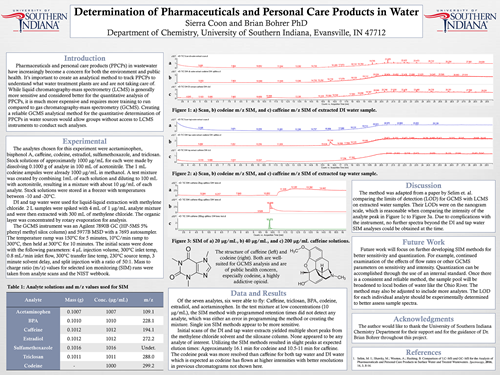
Faculty Mentor: Dr. Brian Bohrer
Pharmaceuticals and personal care products are a growing concern for the environment and public health. Liquid chromatography-mass spectrometry is the preferred method for quantitative analyses of water samples, however it is costly and requires more training to use compared to GCMS. This study focused on developing selective ion monitoring (SIM) methods, which is where the mass spectrometer is set to detect a single mass-to-charge ratio value, increasing sensitivity and enabling the detection of trace compounds. 1000μg/mL stock solutions for acetaminophen, bisphenol A, caffeine, codeine, estradiol, sulfamethoxazole, and triclosan were prepared in acetonitrile solvent. Initial scans determined characteristic mass-to-charge ratio values for each compound which were used in creating SIM methods. Deionized and tap water samples were prepared through liquid-liquid extraction with methylene chloride. Analysis of the samples is ongoing using the previously made SIM methods. Further improvement of sensitivity is being investigated through changes to the GCMS parameters and sample preparation. Future work can focus on completing a quantitative analysis method.
Extraction and Separation of Active Compounds in Ginger and Turmeric
Alexandra Fifer and Hayden Cheek
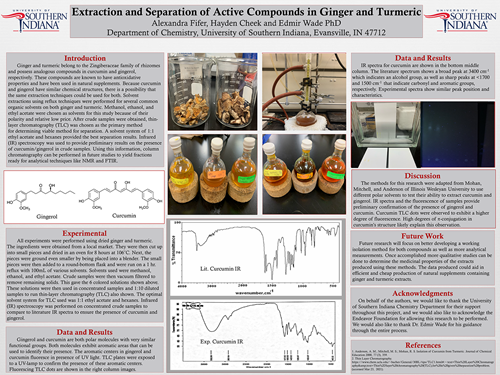
Faculty Mentor: Dr. Edmir Wade
The objective of this research project is to develop and examine different extraction and separation techniques for active ingredients in ginger and turmeric. Ginger and turmeric belong to the Zingiberaceae family of rhizomes and possess analogous compounds in curcumin and gingerol, respectively. These compounds are known to have antioxidative properties and have been used in natural supplements. Because curcumin and gingerol have similar chemical structures, there is a possibility that the same extraction techniques could be used for both. Solvent extractions using reflux techniques were performed for several common organic solvents on both ginger and turmeric. Methanol, ethanol, and ethyl acetate were chosen as solvents for this study because of their polarity and relative low price. After crude samples were obtained, thin layer chromatography (TLC) was chosen as the primary method for determining a viable method for separation. A solvent system of 1:1 ethyl acetate and hexanes provided the best separation results. Using this information, column chromatography can be performed in future studies to yield fractions ready for analytical techniques like NMR and FTIR.
Influence of Clothing and Gender on Potential Occupation
Aubrey Heimer
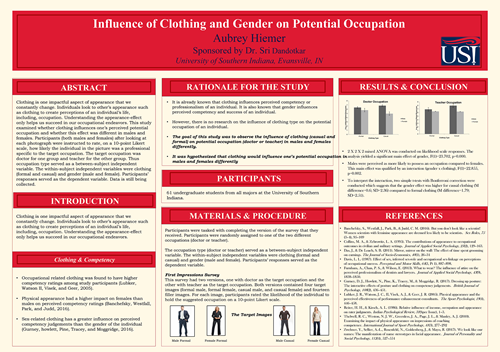
Faculty Mentor: Dr. Srikanth Dandotkar
Clothing is one impactful aspect of appearance that we constantly change. Individuals look to other’s appearance such as clothing to create perceptions of an individual’s life, including, occupation. Understanding the appearance-effect only helps us succeed in our occupational endeavors. This study examined whether this effect was different in males and females. Participants (both males and females) after looking at each photograph were instructed to rate, on a 10-point Likert scale, how likely the individual in the picture was a professional specific to the target occupation. The target occupation was doctor for one group and teacher for the other group. Thus occupation type served as a between-subject independent variable. The within-subject independent variables were clothing (formal and casual) and gender (male and female). Participants’ responses served as the dependent variable. Results indicated a significant main effect of gender on likelihood scale responses. Males were perceived as more likely to possess an occupation compared to females. Analysis suggests that the gender effect was higher for casual clothing, compared to formal clothing.
Generation Z Travel Intentions Post-Pandemic
Katelyn Kuester
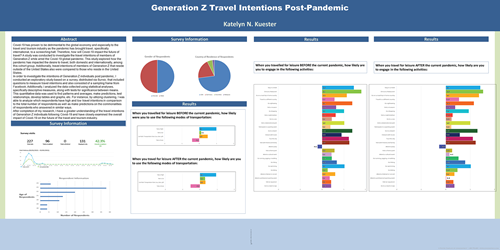
Faculty Mentor: Dr. Peggy Shields
Covid-19 has proven to be detrimental to the global economy and especially to the travel and tourism industry as the pandemic has brought travel, specifically international, to a screeching halt. Therefore, how will Covid-19 impact the future of travel? A study was conducted to investigate the travel intentions of members of Generation Z while amid the Covid-19 global pandemic. This study explored how the pandemic has impacted the desire to travel, both domestic and internationally, among this cohort group. Additionally, travel intentions of members of Generation Z that reside outside of the United States also were compared to those who reside in the United States.
In order to investigate the intentions of Generation Z individuals post pandemic, I conducted an exploratory study based on a survey, distributed via Survio, that included questions to measure travel intentions and also consisted of a sampling frame from Facebook. Additionally, I analyzed the data collected using statistical analyses, specifically descriptive measures, along with tests for significance between means. This quantitative data was used to find patterns and averages, make predictions, test relationships, develop tables and graphs, etc. For instance, by utilizing clustering, I was able to analyze which respondents have high and low travel intentions in comparison to the total number of respondents as well as make predictions on the commonalities of respondents who answered in similar ways.
The Antimicrobial Properties of Epiphyllum oxypetalum and Solanum intergrifolium
Peyton Lengacher
Faculty Mentor: Dr. Henri Maurice
As antibiotic resistance becomes more prevalent, the number of untreatable infections continues to rise at an alarming rate. In addition to this, with very limited antifungal treatments available, fungal resistance can have severe consequences and cause fungal infections to be deemed untreatable. One solution to combatting antibiotic and antifungal resistance is to continue the search for new antimicrobial material in order to increase the number of treatment options available. This experiment contributes to this solution by conducting preliminary research on the antimicrobial properties of two plant species, Epiphyllum oxypetalum and Solanum integrifolium. Leaf samples were taken from these two plant species and extracted in various solutions. Blank antibiotic discs were prepared utilizing the leaf and stem samples and will be used in antibiotic and antifungal susceptibility tests. The bacteria that will be tested are
Escherichia coli, Staphylococcus epidermidis, and Streptococcus mutans. The fungal species that will be tested are Candida, Alternaria, and Fusaria. The zone of inhibition will be measured to determine the antimicrobial activity of these plants. The zones of inhibition will be compared to three antibiotics of known usage including Gentamicin, Tobramycin, and Ampicillin.
Racial Differences in Sport Participation in the U.S. vs. England
Amanda Lewandowski
Faculty Mentor: Ms. Patricia Marcum
Participation in sport offers many benefits and opportunities for growth to people all across the world. However, there are some groups of people who experience barriers or obstacles to sport participation based on racial differences. This paper will explore how racial differences affect sport participation at a variety of levels in the United States and England. In the United States, differing reasons for high school sport participation amongst African Americans and Whites, as well as perceived welcomeness to sport participation at the college level for Hispanics, Latinos, Native Americans and other underrepresented populations will be explored. A higher level of sport will be examined in England, specifically racial difficulties in coaching and amongst amateur soccer or football clubs. These racial differences and barriers to sport participation are a social justice, equity, and fairness issue that is experienced at a global level.
Organic Evolution: A Christian View of Evolutionary Taxonomy
Alex Loepker
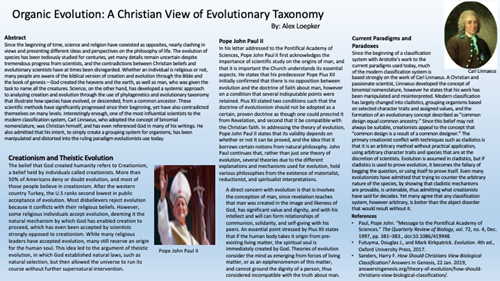
Since the beginning of time, science and religion have coexisted as opposites, nearly clashing in views and presenting different ideas and perspectives on the philosophy of life. The evolution of species has been tediously studied for centuries, yet many details remain uncertain despite tremendous progress from scientists, and the contradictions between Christian beliefs and evolutionary scientists have at times been disregarded. Whether an individual is religious or not, many people are aware of the biblical version of creation and evolution through the Bible and the book of Genesis – God created the heavens and the earth, as well as man, who was given the task to name all the creatures. Science, on the other hand, has developed a systemic approach to analyzing creation and evolution through the use of phylogenetics and evolutionary taxonomy that illustrate how species have evolved, or descended, from a common ancestor. These scientific methods have significantly progressed since their beginning, yet have also contradicted themselves on many levels. Interestingly enough, one of the most influential scientists to the modern classification system, Carl Linnaeus, who adopted the concept of binomial nomenclature, was actually Christian himself, and has even referenced God in many of his writings. He also admitted that his intent, to simply create a grouping system for organisms, has been manipulated and distorted into the ruling paradigm evolutionists use today. This study describes Christian belief on evolutionary taxonomy and addresses the arbitrary errors of phylogenetic methods. Science and religion have been around for ages, and statements declaring one perspective as the ultimate cannot be made due to opinion. Can religion be wrong in its ideas of an arbitrary science, or do evolutionary scientists believe in something that shouldn’t exist?
Examination of the History of Racialization in Medicine and Potential Solutions
Mackenzie Lubbehusen
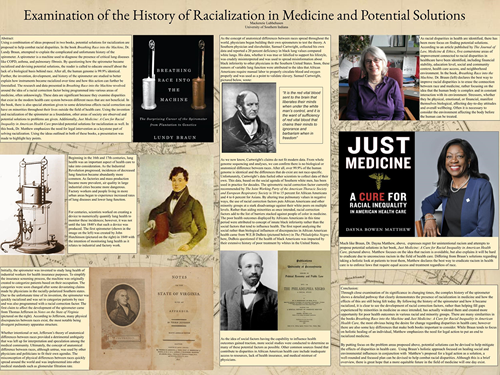
Faculty Mentor: Dr. Kimberley Delaney
Using a combination of ideas proposed in two books, potential solutions for racialization are proposed to help combat racial disparities. In the book Breathing Race into the Machine, Dr. Lundy Braun, attempted to explain the complicated and unfortunate history of the spirometer. By questioning how the spirometer became racialized and devising potential solutions, the reader is called to educate oneself about the lack of a biological basis behind race. After all, the
human genome is 99.9% identical. Further, the invention, development, and history of the spirometer are studied to better explain how instruments became racialized over time and how this action can further be forestalled. The research and data presented in Breathing Race into the Machine revolved around the idea of a racial correction factor being programmed into various areas of medicine, often unknowingly. These data are significant because they examine disparities that exist in the modern health care system between different races that are not beneficial. In the book, there is also special attention given to some deleterious effects racial correction can have on minorities throughout their lives outside the field of health care. Using the invention and racialization of the spirometer as a foundation, other areas of society are observed and potential solutions to problems are given. Additionally, Just Medicine: A Cure for Racial Inequality in American Health Care provided potential solutions for racialization as well. In this book, Dr. Matthew emphasizes the need for legal intervention as a keystone part of solving racialization. Using the ideas outlined in both books, a presentation was made to highlight key points.
Plastic Contaminants at the Surface of Reflection Lake
Alexis Ludge
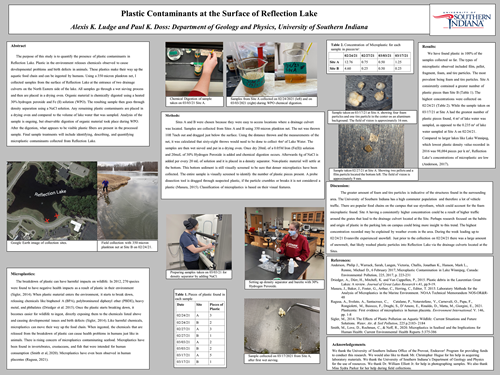
Faculty Mentor: Dr. Paul Doss
The purpose of this study is to quantify the presence of plastic contaminants in Reflection Lake. Plastic in the environment releases chemicals observed to cause developmental problems and birth defects in animals. These plastics make their way up the aquatic food chain and can be ingested by humans. Using a 350 micron plankton net, I collected samples from the surface of Reflection Lake at the entrance of two drainage culverts on the northeastern side of the lake. All samples go through a wet sieving process and then are placed in a drying oven. Organic material is chemically digested using a heated 30% hydrogen peroxide and Fe (ll) solution (WPO). The resulting sample then goes through density separation using a NaCl solution. Any remaining plastic contaminants are placed in a drying oven and compared to the volume of lake water that was sampled. Analysis of the sample is ongoing, but observable digestion of organic material took place during WPO. After the digestion, what appears to be visible plastic fibers are present in the processed sample. Final sample treatments will include identifying, describing, and quantifying microplastic contaminants collected from Reflection Lake.
The Death Positive Movement
Maggie McNeely
Faculty Mentor: Ms. Karen Austin
In the United States, as well as many other countries, death is a taboo topic. The majority of the population fear death, and therefore would like to not confront the matter head on. However, there are many who wish to extinguish this censorship about the topics of death, the process of dying, and what is done with corpses. This is a social movement that encourages conversations about how people are feeling and what they are afraid of, because these fears are shared by many. It is important to discuss your wishes when it comes to after life care, especially with your family. Death is never going to go away, it is a major event that will occur in everyone’s life, so let’s talk about that. I am going to share some of the effects of the Death Positive Movement, and the people who helped shape it to what it is today.
Developing an Enterprise Data Strategy
Elizabeth Nicola

Faculty Mentor: Mr. Josh McWilliams
After contacting a manager at the chosen company and asking several questions about their current business strategies, I chose the least worked upon strategy and will come up with my own. This strategy will help the company improve that specific section of their business. The strategy that was determined to be the best choice was the companies' Enterprise Data Strategy.
Personal Autism Acceptance and Mental Health
Ben Pfingston
Faculty Mentor: Dr. Katherine Daniels
Autism, a developmental condition characterized by difficulties in communication, social functioning, and behavior is often co-morbid with mental health disorders, such as depression and anxiety, which can often make life more difficult for autistic individuals (Nah et al., 2017). Much research has been dedicated to identifying potential risk factors for mental health disorders for this population. Some have examined social factors, such as perceptions of societal acceptance, with relatively consistent results. One other potential risk factor has been identified, self-acceptance of autism diagnosis, but every attempt at measuring it so far has failed (Cage et al., 2018; Cooper et al., 2017). Reasons for these failures include lack of validity, depth, and specificity in the measure. As such, a closer examination of the role of personal autism acceptance is necessary due to the previous failures to measure the construct as well as its potential practical applicability. The current study aims to develop a more valid measure of personal autism acceptance in order to fill this gap, examining the validity of this scale with measures of depression and anxiety. This may allow a more complete view of the factors impacting mental health in autistic adults can be realized. A relationship between autistic self-acceptance and mental health would have implications for improving the mental health of
autistic adults, thus making the presented work clinically relevant.
A Review of Eastern and Western Philosophical Approaches
Abraham Ramsey

Faculty Mentor: Dr. Rocco Gennaro
In this essay I will compare the ideas and approaches of the Eastern and Western philosophical traditions. To achieve this, I will examine general positions on broad topics that each tradition has covered extensively. Though I am comparing each schools’ view on these topics, the aspect I mean to illustrate is the kind of reasoning and assumptions not explicitly expressed in either traditions’ argumentation. In the following discussion of Eastern and Western perspectives on the relationship between mind and body, the power of humans to exert free will, and the role of an all-powerful being, I will show that the perspectives differ primarily in their influence by the Aristotelian true/false dichotomy. While the Western approaches assume that a particular proposition must be either true or false and never both, the Eastern perspectives described below seem to be using a different set of logical assumptions. The following essay will cover thinkers and arguments spanning centuries and continents to create a greater understanding of disparate philosophical approaches and their logical underpinnings.
Social Media and Its Psychological Effects
Jenna Richardson
Social Media has a profound effect on how we see ourselves and the world around us. Every time you log on to Snapchat or Instagram you see pictures of models posing on the beach, a friend that has taken a tropical vacation, or a popstar showing their million-dollar home. Comparing ourselves to the people we see in these photos and videos can make us feel like we need to improve ourselves or that maybe we aren’t quite doing enough in our lives. This leads people to feel insecure about themselves and causes disorders such as anxiety and depression. It can also result in many eating disorders such as anorexia and bulimia since we often compare our bodies to those of models or other famous figures who are prominent on social media. How has our society dealt with the consequences of this and how can we instead use social media to help better the mental health of our community? We will look at the most common psychological disorders caused by excessive social media use, what triggers them, and how we try to solve them by making social media a mental health platform.
Instrumentation Verification of NASA’s GUSTO Project
Alex Russell
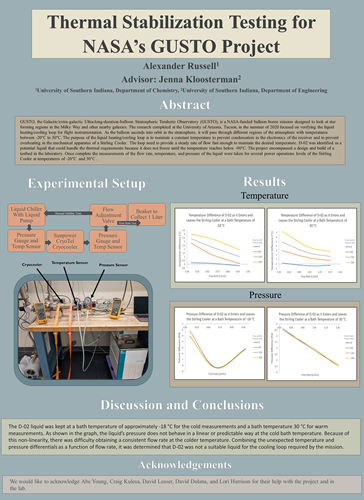
Faculty Mentor: Dr. Jenna Kloosterman
GUSTO, the Galactic/extra-galactic Ultra-long-duration-balloon Stratospheric Terahertz Observatory (GUSTO), is a NASA-funded balloon-borne mission designed to look at star forming regions in the Milky Way and other nearby galaxies. The research completed at the University of Arizona, Tucson, in the summer of 2020 focused on verifying the liquid heating/cooling loop for flight instrumentation. As the balloon ascends into orbit in the stratosphere, it will pass through different regions of the atmosphere with temperatures between -20°C to 30°C. The purpose of the liquid heating/cooling loop is to maintain a constant temperature to prevent condensation in the electronics of the receiver and to prevent overheating in the mechanical apparatus of a Stirling Cooler. The loop needs to provide a steady rate of flow fast enough to maintain the desired temperature. D-02 was identified as a potential liquid that could handle
the thermal requirements because it does not freeze until the temperature reaches below -90°C. The project encompassed a design and build of a testbed in the laboratory. Once complete, the measurements of the flow rate, temperature, and pressure of the liquid were taken for several power operations levels of the Stirling Cooler at temperatures of -20°C and 30°C . Unfortunately, the D-02 liquid was unable to handle the thermal load of the Stirling Cooler and other liquids will need to be investigated.
Facial Expression Identification Accuracy
Banjit Singh
Faculty Mentor: Dr. Srikanth Dandotkar
The goal of this project is to find if there are any differences in the accuracy of anger recognition in own-race faces compared to other-race faces. Participants (African American and Caucasian) were shown twenty faces that either matched their race or were other-race faces. These faces were split evenly between men and women and four of them from each set showed angry expressions. Participants were asked to identify the facial expression they were shown between anger, fear, surprise, joy, disgust, and sadness. These expressions were chosen due to previous research indicating that these are universally recognizable. The manipulated variable was the set of faces that were being shown to the group of Caucasian or African American participants, same-race or other-race. The dependent variable was the average accuracy in which anger was identified. The results suggest that, within the small sample size, the average difference in accuracy scores were different for Caucasians between matching and nonmatching conditions compared to the average difference in accuracy scores for African Americans between matching and nonmatching conditions. In fact, the average difference was higher for Caucasians than for African Americans.
Psychology of Music
Lindsey Sparks
Music is a part of almost everyone’s daily lives and may have more of an effect on our well-being than we think. Music can improve language skills, creativity, and happiness, as well as improve some neurological disorders. In fact, studying music can lead to higher standardized test scores. Ultimately, music can lead to more successful life outcomes. Music can be so effective that it has found its place in therapy. Music therapy can promote self-regulation and coping skills, especially for those that have had traumatic experiences. Music can provide individuals the ability to express themselves in ways they could not otherwise do with words. Studies have shown that music can lower blood pressure and anxiety in individuals with heart disease. Brain chemicals such as dopamine, cortisol, and serotonin have shown to be affected by listening to music as well. It is evident that music can have a positive impact on our lives, and understanding these effects can help more people live a happier and healthier life.
Education Tools to Develop Thriving Mentoring Relationships
Ciara Terry
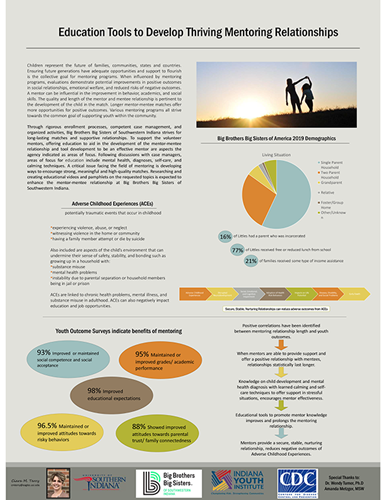
Faculty Mentor: Dr. Wendy Turner
Children represent the future of families, communities, states and countries. Ensuring future generations have adequate opportunities and support to flourish is the collective goal for mentoring programs. When influenced by mentoring programs, evaluations demonstrate potential improvements in positive outcomes in social relationships, emotional welfare, and reduced risks of negative outcomes. A mentor can be influential in the improvement in behavior, academics, and social skills. The quality and length of the mentor and mentee relationship is pertinent to the development of the child in the match. Longer mentor-mentee matches offer more opportunities for positive outcomes. Various mentoring programs all strive towards the common goal of supporting youth within the community.
Through rigorous enrollment processes, competent case management, and organized activities, Big Brothers Big Sisters of Southwestern Indiana strives for long-lasting matches and supportive relationships. To support the volunteer mentors, offering education to aid in the development of the mentor-mentee relationship and tool development to be an effective mentor are aspects the agency has indicated as areas of focus. Following discussions with case managers, areas of focus for education include mental health, diagnoses, self-care, and calming techniques. A critical issue facing the field of mentoring is developing ways to encourage strong, meaningful and high-quality matches. Researching and creating educational videos and pamphlets on the requested topics is expected to enhance the mentor-mentee relationship at Big Brothers Big Sisters of Southwestern Indiana.
Sex Differences in Stress Response to an Objectification Environment
Erica Uebelhor
Faculty Mentor: Dr. Urska Dobersek
Perceptions of oneself and others have significant impact on individuals’ health and well-being. For example, self-objectification (SO), treating oneself as an object, has a myriad of negative psychological ramifications (e.g., shame, anxiety) and, in concert with physiological arousal (e.g., altered heart rate – HR, cortisol), can engender significant mental health problems (e.g., eating disorders, depression, sexual dysfunctions). However, there are counter-intuitive and paradoxical findings (e.g., decreased HR) that warrant further investigation. Thus, the purpose of this study was to examine sex differences in stress response (i.e., cortisol production) to an objectified environment.
Our sample consisted of 80 undergraduate college students (nfemales = 40, nmales = 40, Mage = 18.79, SD = 0.96, BMI = 24.02) between 18 and 23 years of age from the U.S. They completed a demographic questionnaire and were randomly assigned to either the experimental group (i.e., wearing revealing exercise attire) or the control group (i.e., wearing baggy exercise attire). After the manipulation, they completed a state Self-Objectification Questionnaire and provided a saliva sample. A 2 (sex: males/females) x 2 (groups: experimental/control) between subjects Analysis of Variance demonstrated a main effect for groups where experimental group (M = 0.31, SD = 0.04) had significantly higher cortisol levels than control group (M = 0.29, SD = 0.04), F(1, 76) = 4.86, p = .03, ηp2 = .06. The main effect for sex (p = .39) and interaction between sex and groups (p = .28) was not statistically significant.
Our findings are congruent with some of the existing research suggesting that social- or self-evaluations lead to increased cortisol levels, and also contradictory with some of the previous literature that found decreased physiological arousal (i.e., HR) due to the orienting response. At the practical level, social- and self-evaluations (e.g., wearing more revealing clothing) can impact one’s performance.
Periodontal Disease: Probiotics vs Antibiotics
Morgan Wadsworth and Mackenzie Mullins
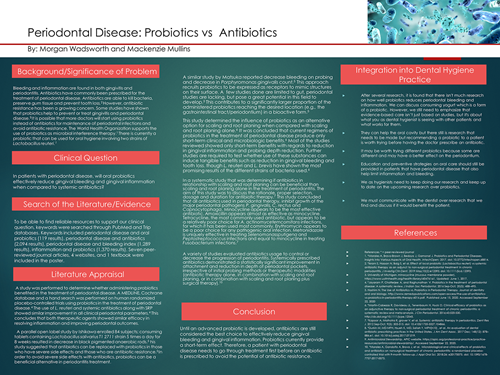
Faculty Mentor: Ms. Emily Holt
Bleeding and inflammation are found in both periodontal diseases diagnosed as gingivitis and periodontitis. Antibiotics can kill bacteria, preserve gingival tissue, and prevent tooth loss in periodontal disease cases not responding to normal treatments. However, antibiotic resistance has been a growing concern. Some studies have shown that probiotics help prevent or treat periodontal inflammation.
In patients with periodontal disease, will oral probiotics effectively reduce gingival bleeding and gingival inflammation when compared to systemic antibiotics? A 2016 systematic review concluded that current regimens of probiotics in the treatment of periodontal disease produce only short-term clinical and microbiologic benefits. A 2020 parallel open-label study concluded that the administration of beneficial bacteria in the form of probiotics can be a valuable alternative in the treatment of periodontitis. A 2016 meta-analysis seem to support the adjunctive use of L. reuteri to nonsurgical periodontal therapy in the treatment of periodontitis at short-term, especially in deep pockets. Overall, antibiotics are still considered the best choice to effectively reduce gingival bleeding and gingival inflammation. Probiotics currently provide a short-term effect. A patient with periodontal disease needs to receive nonsurgical periodontal treatment before an antibiotic is prescribed to avoid the potential of antibiotic resistance. Studies related to the effects of probiotics on gingival bleeding are lacking but pose a great potential for development. Minocycline is the antibiotic of choice when it comes to treating refractory periodontitis. Antibiotics demonstrate a statistically significant improvement in attachment and reduction in the depth of periodontal pockets.
Mental Health Perceptions
Lauren Ward
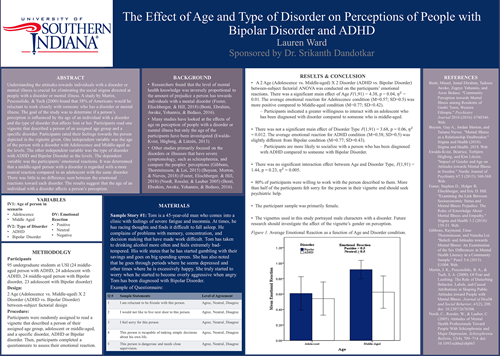
Faculty Mentor: Dr. Srikanth Dandotkar
The goal of the study was to determine if a person’s perception is influenced by the age of an individual with a disorder and the type of disorder that affects him or her. Participants read one vignette that described a person of their assigned age group, adolescent or middle-aged, and a specific disorder, ADHD or Bipolar disorder. Participants rated their feelings concerning the person depicted for the vignette given. One independent variable was the age of the person with a disorder with Adolescence and Middle-aged as the levels; this was a between-subject variable. The other independent variable was the type of disorder with ADHD and Bipolar Disorder as the levels; this was a between-subject variable. The dependent variable was the participants’ emotional reactions. It was determined that a middle-aged person with a disorder is regarded with a more neutral emotional reaction compared to an adolescent with the same disorder.
There was little to no difference seen between the emotional reactions toward each disorder. The results suggest that the age of an individual with a disorder affects a person’s perception.
Sequencing and phylogenetic analysis of the mitogenomes of the least brook lamprey, Lampetra aepyptera (Cyclostomata: Petromyzontidae)
Hans Webber and Nikhitha Lavu

Faculty Mentors: Drs. Kimberley Delaney and Rex Strange
The least brook lamprey is a non-parasitic native to the rivers and creeks of the midwestern and southeastern United States. In this study, the complete mitochondrial genome of this organism will be sequenced and compared to those of other related individuals and species of lamprey. Unlike nuclear DNA, mitochondrial DNA is defined by its lack of recombination, maternal inheritance, augmented mutation rate, and scarce non-coding regions. For these reasons,
sequencing the mitogenome allows for lineages to be discerned, providing insight into the intricate relationships between individuals of the same species. We propose to investigate these relationships in individuals that are geographically isolated in different bodies of water. These relationships will aid in the construction of a phylogenetic tree, that will contribute a more robust basis for the evolution of these organisms. Early research from initial trials provided high quality sequencing data which confirm the predicted level of similarity to other species including the southern brook lamprey (Ichthyomyzon gagei) and sea lamprey (Petromyzon marinus). This project will yield implications that will prove essential for future genomic studies of the molecular
evolution of basal vertebrates.
The Effect of Emotional Arousal and Gender on Self-Confidence
Madison Wentzel
Faculty Mentor: Dr. Srikanth Dandotkar
Negative emotions can affect various behaviors and thoughts. When one is under negative emotional arousal or induction, their behavior is different from what it would be under neutral and positive emotional arousal or induction. Studies have shown how negative emotions affect one’s behavior. How one feels about themselves when experiencing negative emotion has not been researched. The purpose of the study was to investigate whether emotion arousal (fear, anger) has an effect on one’s self-confidence and whether this effect was different for male and female participants. Participants completed an emotional arousal activity. Participants' self-confidence was measured with the Rosenberg-Self Esteem Questionnaire. Participant’s aroused emotion served as a between subject independent variable with anger and fear as the two levels. Gender served as the second between subject independent variable with male and female as the two levels. Participant’s self-confidence scores served as the dependent measure. It was hypothesized that the type of emotional arousal (fear, anger) affects self-confidence of male and female participants differently. The average confidence score for the anger group (M=31.78, SD=, SD=6.5) was not different from that of the fear group (M =30.39, SD=6.6). It seems like emotion does not affect self-confidence in this study. Despite the small sample size and pvalues, there is a slight indication that males in the anger group had higher self-confidence than males in the fear group.
